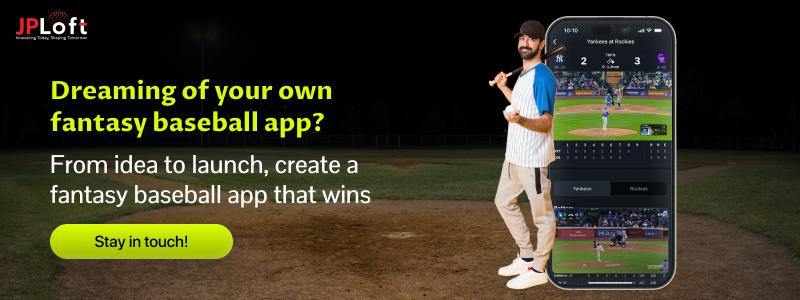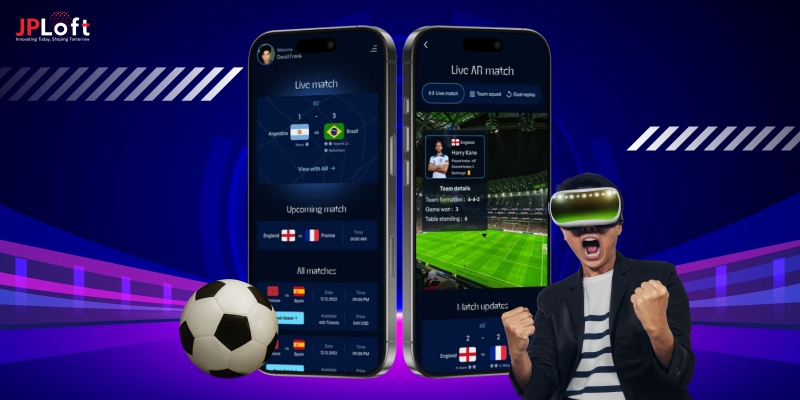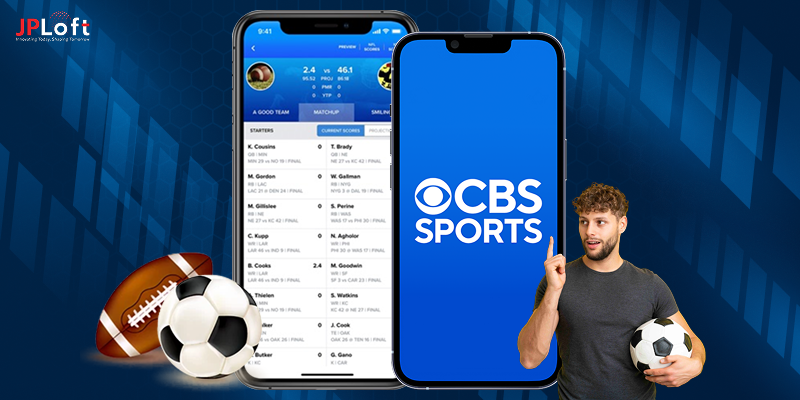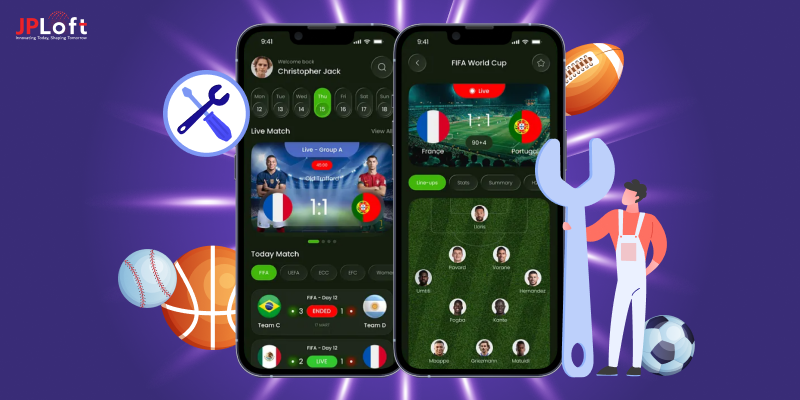To create a fantasy baseball app, you need a clear strategy, strong features, and the right technology to bring it all together.
With the fantasy baseball market valued at $1.5 billion in 2024 and expected to reach $3.2 billion by 2033, it’s clear that this digital sport is gaining serious momentum.
As the demand for interactive sports platforms continues to rise, businesses and startups are exploring how to develop a fantasy baseball app that stands out in this competitive space.
This fantasy baseball app development guide will walk you through the complete process, covering must-have features, tech stack, cost estimation, and monetization strategies to help you build a successful and engaging app from scratch.
Key Takeaways:
Fantasy baseball is projected to reach $3.2B by 2033, and now is the time to invest.
Key features of fantasy baseball are real-time player stats, live draft systems, league creation, in-app chat, and payment integration.
A step-by-step approach from market research and competitor analysis to UI/UX design helps to launch and ensure app success.
Using technologies like React Native, Node.js, Firebase, and real-time APIs ensures fast performance, seamless user interaction, and scalability across different platforms.
Fantasy baseball apps can be monetized through entry fees, in-app purchases, advertisements, freemium upgrades, and affiliate sales.
Partnering with an experienced company like JPLoft can help ensure your app isn’t just technically sound, but also innovative, scalable, and aligned with user expectations.
What is the Fantasy Baseball App?
A fantasy baseball app is a digital platform where users create virtual baseball teams using real-life players and compete based on their actual game performances. Players earn points based on stats like runs, home runs, strikeouts, and more, making it a mix of strategy, skill, and real-time sports excitement.
Users can join public or private leagues, manage their rosters, make trades, and track live scores throughout the season. These apps provide an engaging way for baseball fans to stay connected with the sport while competing with friends or other fans.
Whether it's casual play or high-stakes fantasy leagues, a well-built fantasy baseball app offers a dynamic user experience that blends entertainment, analytics, and sports passion in one seamless interface.
Market Statistics of Fantasy Baseball App
Before diving into development, it’s always smart to check out how the market is performing. Below are some key statistics to give you a clear picture of the fantasy baseball app industry:
-
- According to Statista, the revenue is projected to grow at a compound annual growth rate (CAGR) of 4.68% between 2025 and 2029, reaching an estimated market volume of $17.12 billion by 2029.
- With the rise of NLP, fantasy apps are adopting voice assistants and chatbots to enhance real-time user interactions.
- A study by Verified Market Reports shows that the Fantasy Baseball market was valued at $1.5 billion in 2024 and is expected to grow to $3.2 billion by 2033, showcasing a CAGR of 9.3% from 2026 to 2033.
- Grand View Research reported that the global fantasy sports market was valued at $24,853.7 million in 2024 and is projected to reach $56,381.2 million by 2030, with a CAGR of 15.2% from 2025 to 2030.
These numbers clearly show that the fantasy baseball app industry is on a strong upward direction. With increasing user engagement, tech innovation, and market size, now is a great time to tap into this booming space.
If you aim to build a future-ready app, keeping up with these stats and trends is a smart first step.
Why Should You Invest in a Fantasy Baseball App Development?
The world of fantasy sports is booming, and baseball remains one of the most popular games in this space. If you're wondering why it is the right time to invest in fantasy baseball app development, here are some solid reasons:
1. High User Engagement
Fantasy baseball apps offer a thrilling experience for fans who enjoy managing virtual teams based on real-world performances.
This interactive format keeps users actively involved throughout the sports season, leading to higher retention rates and regular app usage. With the right UX and real-time features, your app can become a daily habit for users.
2. Growing Market Demand
Baseball enjoys a massive fan base across the globe, particularly in the U.S., Japan, and Latin America. With the rising popularity of fantasy sports, there’s an increasing demand for dedicated platforms that offer smooth, reliable, and real-time fantasy gameplay.
This surge in interest makes it the perfect time to tap into the market and build your user base.
3. Multiple Revenue Opportunities
Fantasy baseball app opens the door to a variety of monetization strategies. You can earn through entry fees, premium subscriptions, in-app purchases, advertising partnerships, and even branded sponsorships.
When you add the right monetization model, your app not only makes a fantasy baseball app that entertains users but becomes a consistent revenue stream.
4. Brand Visibility & Loyalty
Developing your own fantasy baseball platform gives your brand an innovative edge in the sports-tech market.
It helps in building a loyal community around your brand, especially if you provide great features, real-time engagement, and rewards. The app becomes a space where fans associate positive experiences with your business.
5. Scalable Business Model
Whether you’re a startup testing how to develop a fantasy baseball app to dominate the sports gaming space, fantasy baseball apps offer a highly scalable business model.
You can start with essential features and grow steadily by adding new sports, functionalities, or gamification layers as your audience grows.
6. Broader Business Potential
If you're looking to expand your reach, you can even develop a fantasy sports app that includes multiple games beyond just baseball.
This flexibility allows your business to scale and appeal to a broader sports audience without starting from scratch each time.
So, if you're ready to tap into a high-growth, fan-driven market, this is your chance.
With the right team and vision, you can create a fantasy baseball app that not only entertains but also drives serious business value.
Let’s explore what features your app absolutely needs to succeed.
Must-Have Features in a Fantasy Baseball App
To build a fantasy baseball platform that truly engages users, you need more than just a sleek design, you need solid, user-focused features.
Whether you're just learning about development or are ready to scale up, here are the features every fantasy sports app must have for long-term success:
1] User Registration & Profile Management
The first impression matters. Allow users to sign up easily using email, mobile, or social media accounts.
Once registered, users should be able to personalize their profiles, view performance history, and manage preferences, all key to a smooth onboarding experience.
2] Drafting System
The draft is the heart of any fantasy baseball league app. Let users build their teams by selecting real-life players, either through live draft rooms or auto-draft modes.
Offering different draft formats adds excitement and allows your app to cater to all kinds of users, casual players and fantasy pros alike.
3] Real-Time Score Updates & Player Stats
Your app must feel alive. Integrating real-time player stats and live match scores keeps users engaged throughout the season.
It’s one of the most crucial features in fantasy baseball mobile app development, as it drives both competition and interaction.
4] League Creation & Management
Users should be able to create custom leagues, public or private, with flexible scoring rules, team limits, and invite options.
A good league management feature gives users a sense of ownership, making them more invested in your platform.
5] Team Management & Player Trading
To make your app dynamic, allow users to update their lineups, bench players, or trade them with others in the league.
These real-time decisions simulate the thrill of managing a real team and add depth to your app.
6] Push Notifications & Match Alerts
Push notifications are key for user retention.
Keep your users informed with timely updates on player performances, match results, trade confirmations, and league news.
This real-time interaction keeps them coming back.
7] In-App Chat & Community Features
Social interaction is often what makes fantasy games fun.
Include features like league chats, direct messaging, and discussion boards to encourage community engagement.
This helps to make your app more than a game, it becomes a community.
8] Payment Gateway Integration
If you plan to run paid contests or offer premium features, a secure and seamless payment integration is a must.
Whether it's joining leagues, withdrawing winnings, or purchasing boosts, payments should be fast and trustworthy.
9] Admin Dashboard & Analytics
Behind every great user-facing app is a strong admin panel.
During fantasy baseball software development, ensure you have tools to manage users, monitor activity, adjust league settings, and access analytics to improve performance and security.
10] Cross-Platform Compatibility
Your users won’t just be on one device.
Whether they’re using Android, iOS, or the web, your fantasy baseball mobile app should deliver a smooth experience everywhere.
It’s essential for scaling when you want to start an online fantasy sports app that reaches more people.
By including these core features, you're not only enhancing the user experience but also setting your app up for long-term success. Whether you’re building an MVP or a fully-featured platform, these essentials will guide your app development journey in the right direction.
Step-by-Step Guide to Develop a Fantasy Baseball App
If you're planning to create a fantasy baseball app, you're entering a growing market full of opportunity. But success lies in building a robust, feature-rich platform that engages users from draft day to the final pitch.
This section will walk you through the step-by-step process to develop a fantasy baseball app, ensuring you're equipped with everything from planning to launch and beyond.
Let’s break it down.
Step 1: Market Research & Competitor Analysis
Every successful app starts with understanding the market. Begin by analyzing current fantasy sports app trends and exploring what users like or dislike about the baseball apps, you can understand the market demand.
Identify gaps in features, pain points, and opportunities for innovation. What kind of gameplay do users prefer in a fantasy baseball league app? What monetization models work best?
Deep research at this stage helps define your unique value proposition. It also helps you decide whether you want to build custom fantasy baseball app solutions or adapt an existing model.
Step 2: Define Your App Goals & Target Audience
Now that you understand the market, clearly define your app’s purpose. You have to make sure that you are targeting casual fans or hardcore fantasy baseball enthusiasts.
Be clear on whether you want to create a daily league app or seasonal league model.
This is also the stage to decide what kind of fantasy baseball mobile app you want to build, iOS, Android, or cross-platform.
Align your business goals with your audience’s expectations to set a strong foundation and avoid expensive changes later in the development process.
Step 3: Finalize the Feature Set & App Flow
When you develop a fantasy baseball app, the right feature set is key to ensuring user engagement and long-term success. Your app must include real-time player statistics, live drafts with auto-pick options, and tools for league creation and management.
Scoreboards and leaderboards add a competitive edge, while push notifications and social media integrations enhance user interaction and retention.
Beyond just features, focus on the complete user journey, from onboarding and team creation to tracking scores and viewing league results. Mapping this journey helps refine the app design and ensures a smooth, intuitive user experience that keeps players coming back.
Step 4: Choose the Right Technology Stack
Picking the technology stack for fantasy baseball app is a crucial step.
You’ll need a mix of frontend (like React Native or Flutter), backend (Node.js, Laravel), real-time data APIs (for match updates and player stats), and cloud storage solutions (like AWS or Firebase).
Your development team should choose scalable technologies that can support high-traffic times, like during major baseball games or league drafts.
If you're new to this, consider consulting the best mobile app development company who specialize in fantasy baseball software development.
Step 5: Design the UI/UX
A clean, intuitive, and responsive design can make or break your fantasy app. Start with app wireframing to outline each screen and interaction, followed by app prototyping to visualize how users will experience the app in real-time.
This process helps fine-tune the layout and usability before full development begins. Your fantasy baseball mobile app should reflect the excitement of live games while ensuring easy navigation.
Designers must keep up with modern UI/UX trends and ensure the design aligns with your brand identity. Whether you're building a dark-themed interface for gamers or a clean sports dashboard, the focus should always be on enhancing engagement and delivering a seamless experience.
Step 6: Start Developing Fantasy Baseball App
Once the designs are finalized, the core fantasy baseball app development guide moves into coding. Developers build both the frontend and backend simultaneously, integrating the database, APIs for real-time stats, and admin panel functionalities.
Here, it's vital to implement scalable architecture, allowing your fantasy baseball app startup idea to grow as your user base expands. Focus on building an MVP (Minimum Viable Product) first, one that includes your core features and can be tested by early adopters.
If you want to create a fantasy baseball app that stands out, consider hiring mobile app developers with custom algorithms for scoring, user ranking, or even AI-based draft suggestions.
Step 7: Testing & QA
Before launch, perform thorough app testing on multiple devices to ensure your fantasy baseball software development is bug-free. Functional testing, security audits, performance testing, and real-time data validation are crucial here.
Fantasy sports apps rely on real-time scoring and performance data, so even a small lag can ruin the experience. Test for every scenario, from mid-match server loads to real-time leaderboard updates to ensure a seamless user journey.
Step 8: Launch & Deployment
Once your fantasy baseball app is fully developed and tested, it’s time to launch. If you’re targeting iPhone users, you’ll need to submit an iOS app to the App Store, making sure it meets Apple’s guidelines and passes their review process.
For Android users, you can publish apps to Google Play Store to ensure quick accessibility across a wider audience. Regardless of the platform, always prepare a solid ASO (App Store Optimization) plan with strong visuals, keyword-rich descriptions, and user support in place.
Launching is just the beginning, continue tracking performance and user feedback to refine your app experience over time.
Step 9: Marketing & User Acquisition
Even the most well-designed app needs a push to reach users. Use social media campaigns, influencer collaborations, referral programs, and content marketing to spread the word.
This is also the time to leverage SEO, target long-tail keywords related to your fantasy baseball app in your blog posts, landing pages, and promotional content.
You can also offer limited-time discounts or free entry leagues to attract your first wave of users.
Step 10: Ongoing Support, Maintenance & Feature Upgrades
The launch is just the beginning. To keep users engaged and retain loyalty, you must keep improving your app. Regular updates, app maintenance service, seasonal themes, fantasy league innovations, and bug fixes will go a long way.
Stay updated with the latest fantasy baseball app trends and user feedback to drive improvements. You can add new monetization models, data visualization features, or social interaction tools over time.
If needed, hire dedicated developers for long-term app maintenance and feature scaling.
By following this step-by-step process to develop a fantasy baseball app, you're setting yourself up for long-term success in a high-growth market.
With the right team, strategy, and tech stack, you can build a fantasy baseball app that’s not only fun and engaging, but also profitable and scalable.
Tech Stack Required to Build a Fantasy Baseball App
To bring your fantasy sports app design to life, you need the right combination of technologies, both on the front end and the back end.
Here's a basic breakdown of the tech stack you'll need to develop a smooth, real-time, and engaging fantasy baseball app:
► Frontend Development
Use React Native or Flutter if you want to build a cross-platform app. These frameworks offer faster development and a smooth user interface across Android and iOS. For platform-specific development, Swift works best for iOS and Kotlin for Android.
Why it's important:
React Native and Flutter reduce time-to-market while maintaining performance, and Swift/Kotlin ensure native-level speed and device optimization.
► Backend Development
Your app’s engine runs on the backend. Technologies like Node.js, Python (Django), or Ruby on Rails are popular choices because they’re scalable and support real-time data updates, essential for fantasy sports gameplay.
Why it's important:
These technologies are efficient, developer-friendly, and great for handling large user traffic and real-time functionalities.
► Database
A fast and reliable database like MongoDB, PostgreSQL, or Firebase Realtime Database helps manage user profiles, match data, scores, and league stats efficiently.
Why it's important:
These databases offer high performance, scalability, and real-time syncing, ideal for apps that need instant data access.
► Real-Time Data & APIs
To deliver live updates, integrate real-time sports data APIs like SportRadar, FantasyData, or MySportsFeeds. These power up your fantasy leagues with live scores, player stats, and schedules.
Why it's important:
These APIs are trusted in the sports industry and provide accurate, real-time stats crucial for fantasy game accuracy and engagement.
► Authentication & Security
Use OAuth 2.0, Firebase Authentication, or JWT tokens for secure user login, especially when users join leagues or make payments.
Why it's important:
These methods are industry-standard for protecting user identity and payment data while ensuring seamless login experiences.
► Cloud & Hosting Services
Platforms like AWS, Google Cloud Platform, or Microsoft Azure provide the storage, server power, and scalability your app needs, especially during peak gameplay hours.
Why it's important:
These cloud giants offer auto-scaling, robust security, and global reliability, perfect for handling traffic spikes and ensuring uptime.
Choosing the right tech stack is crucial for your app design to be fast, fun, and reliable. Make sure your developers are comfortable with these tools and that everything works seamlessly across platforms.
How Much Does It Cost to Build a Fantasy Baseball App?
Wondering how much you’ll need to invest to bring your fantasy baseball app idea to life? The cost to develop a fantasy sports app can vary based on the features, design, tech stack, and development team you choose.
On average, the cost to build a fantasy baseball app ranges from $20,000 to $150,000+. A basic app with core features can be built on the lower end of this range, while a high-end app with real-time data, advanced analytics, and a rich app design will cost significantly more.
Your expenses also depend on whether you're building for one platform or both (iOS & Android), and if you're adding features like live chat, admin panel, or monetization modules.
Let’s dive into the detailed cost breakdown.
|
App Component |
Estimated Cost (USD) |
Description |
|
UI/UX Design (Fantasy Sports App Design) |
$2,000 – $10,000 |
Designing a user-friendly interface and engaging experience for your app. |
|
Frontend & Backend Development |
$10,000 – $70,000 |
Core coding work to build the app’s logic, user interface, and server-side. |
|
Real-Time Data Integration (APIs) |
$3,000 – $15,000 |
Integration of live match stats, player updates, and game analytics. |
|
User Authentication & Security |
$1,000 – $5,000 |
Features like login, signup, and secure user data handling. |
|
Payment Gateway Integration |
$1,500 – $7,000 |
Enabling in-app purchases, wallet features, or paid contests. |
|
Admin Panel |
$2,000 – $10,000 |
Dashboard for app owners to manage users, games, and transactions. |
|
Testing & QA |
$1,000 – $5,000 |
Ensuring the app runs smoothly without bugs across devices and platforms. |
|
Post-Launch Support & Maintenance |
$2,000 – $15,000+ |
Ongoing updates, feature improvements, and technical support. |
This breakdown helps you understand where each dollar goes when planning the cost to create a fantasy baseball app. If you want to reduce your initial spend, start with a basic version (MVP), and scale once your app gains traction.
Challenges in Fantasy Baseball App Development
Building a fantasy baseball app isn’t just about cool features and clean design. Behind the scenes, there are some real technical and strategic hurdles that developers need to tackle.
Let’s take a look at some of the most common fantasy sports app development challenges that can come your way:
A] Real-Time Data Integration
Keeping your app synced with live baseball stats is no small feat. You need reliable third-party APIs that deliver real-time performance updates, injuries, and match outcomes without lag.
B] User Retention & Engagement
Let’s face it, users can get bored quickly. One of the biggest challenges is keeping the game exciting with new features, notifications, and a smooth gameplay experience.
C] Compliance with Legal Regulations
Fantasy baseball apps operate in a grey legal area in some regions. You’ll need to ensure your app complies with gaming laws and data privacy rules depending on where it’s available.
D] Scalable Architecture
A sudden rise in users during league seasons can crash poorly built systems. Your app needs a robust backend to handle massive traffic without slowing down.
E] Designing for Multiple Platforms
Creating a seamless experience across iOS, Android, and the web isn’t easy. Each platform requires custom UI adjustments and testing for consistency.
Overcoming these challenges is key to building a successful, reliable, and fan-favorite fantasy baseball app. With the right team and tools, every hurdle becomes a stepping stone toward a winning platform.
Tips from Experts: Building a Successful Fantasy Sports Platform
Creating a fantasy sports platform that stands out in today’s competitive market takes more than just a great idea, it needs strategy, innovation, and smart execution.
Here are some expert-approved tips to help you to create an app that users love:
1. Start with User-Centric Design
Whether you want to make a fantasy baseball app for beginners or seasoned players, focus on intuitive navigation, a sleek interface, and responsive gameplay that works flawlessly on all devices.
2. Offer a Seamless Mobile Experience
More than 80% of users play on their phones. That’s why investing in a powerful Fantasy baseball mobile app is key. Make sure it’s optimized for both iOS and Android, with fast loading times and engaging UI elements.
3. Leverage AI, ML & NLP
Want to make your platform smarter? AI and machine learning can help in player performance prediction, fraud detection, and personalized recommendations. Natural language processing (NLP) can be used for smart chatbots or voice-based queries, perfect for enhancing the user experience.
For this, you can partner with a reliable AI development service to integrate intelligent features that truly stand out.
4. Real-Time Analytics & Insights
Players love to track progress and stats. Integrate real-time dashboards and visual performance graphs to keep users engaged and informed throughout the fantasy league.
5. Secure & Scalable Fantasy Baseball Software Development
Security matters. A successful fantasy app must ensure safe transactions, secure user data, and a scalable backend to handle heavy traffic, especially during live matches or playoffs.
By combining smart strategy, seamless design, and technologies like AI and ML, your fantasy platform can become the next big hit in the sports-tech world.
Fantasy Baseball App Monetization Strategies
If you are looking for how to turn your fantasy app into a revenue-generating machine, then here are five proven monetization strategies to consider:
- Entry Fees & Cash Contests: Charge users a small entry fee to participate in premium leagues and contests with cash rewards. It’s a popular and effective way to boost engagement and income.
- In-App Purchases: Offer special features like player stats boosters, advanced analytics, or draft guides as paid upgrades inside the app.
- Advertisements & Sponsorships: Partner with sports brands or display targeted ads. This passive income stream works well, especially during peak sports seasons.
- Freemium Model: Provide a basic free version and lock advanced features behind a paywall. This encourages users to upgrade for a better experience.
- Affiliate Marketing & Merchandise Sales: Promote sports gear, tickets, or partner products through the app and earn a commission on sales.
With the right fantasy sports app monetization mix, you can turn your app into the best app in the game, both in user base and profitability.
What Makes JPLoft the Best Choice for Fantasy Baseball App Development?
When it comes to developing the fantasy baseball app, JPLoft stands out with its experience, creativity, and commitment to quality. As a leading fantasy sports app development company, we specialize in building custom fantasy baseball platforms tailored to your goals and audience.
From real-time scoring integration to smooth UI/UX and monetization strategies, our team ensures your app is not just functional but fun and future-ready. Whether you're starting from scratch or scaling an existing idea, we combine technology and sports insight to bring your vision to life.
We don’t just build apps, we create winning experiences. Let us help you turn your dream fantasy baseball app into a successful digital product.
Final Wrap-Up
Now is the perfect time to create a fantasy baseball app that stands out in the ever-growing world of fantasy sports. With the right features, tech stack, and development team, you can build a platform that delivers real-time excitement and long-term user engagement.
Whether you're targeting casual fans or hardcore baseball lovers, investing in fantasy app development offers real potential for growth and revenue.
We’ve covered everything from benefits to development insights, now it's your move. With the right approach, your fantasy baseball app could be the next big hit in the sports tech space.
FAQs
The cost can vary based on features, platform, and complexity, typically starting from $20,000 to $150,000+.
On average, it takes 3 to 6 months to design, develop, and launch a full-featured app.
Key features include user login, draft system, real-time scoring, league management, payments, and notifications.
Yes, integrating real-time stats via licensed APIs (like MLB data providers) ensures accuracy and engagement.
Absolutely! Popular monetization options include entry fees, in-app purchases, ads, and premium memberships.













Share this blog